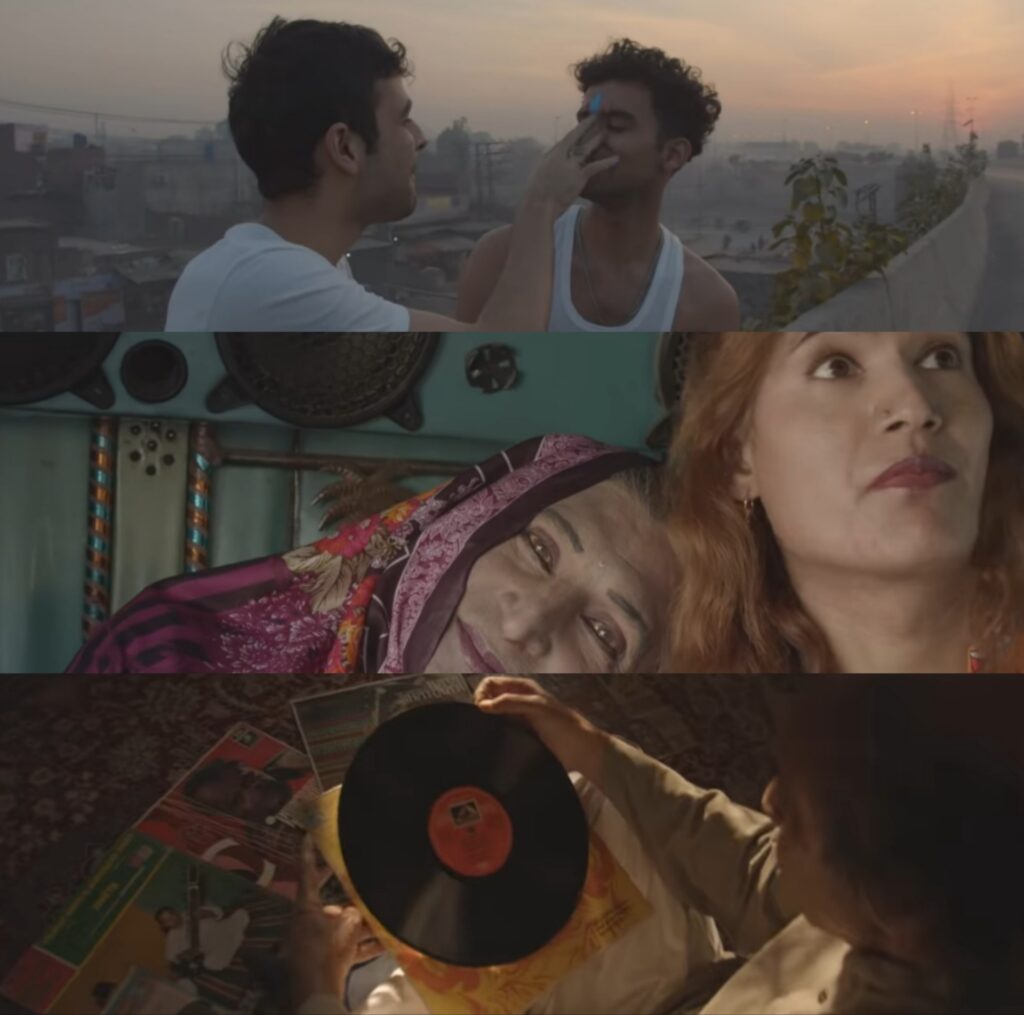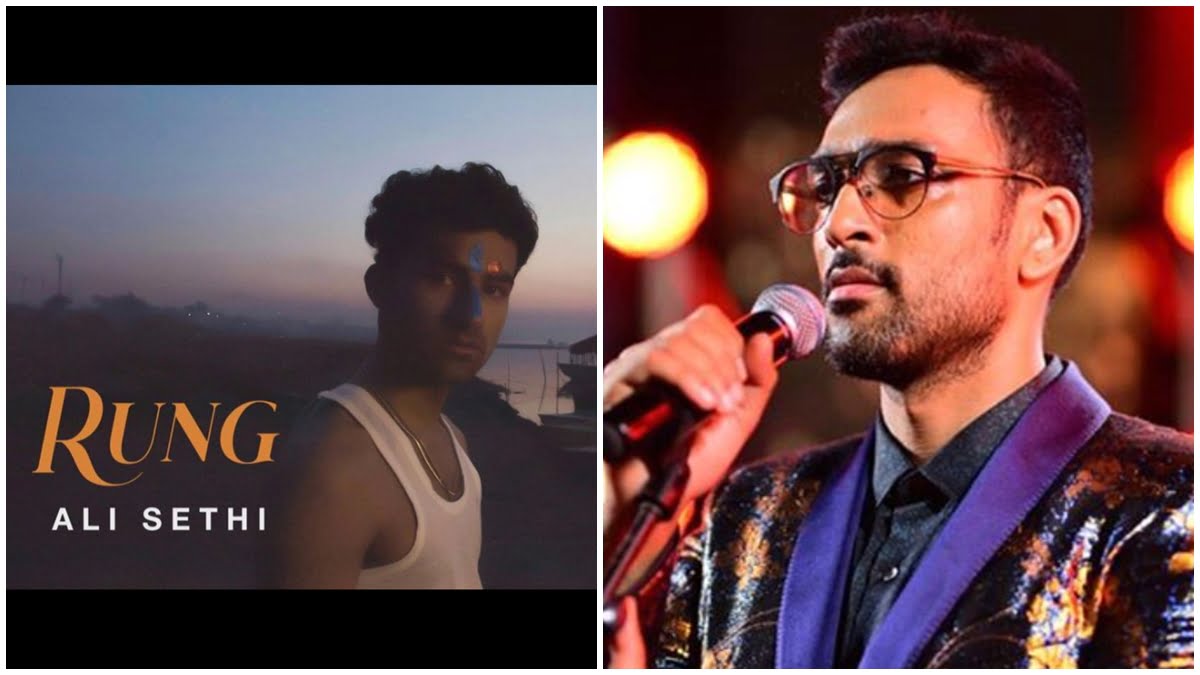In March 2021, the popular Pakistani musician and writer Ali Sethi surprised his audience yet again with another aesthetically rich musical release. The album was released under the title Rung just around International Women’s Day this year. The song, largely filmed in Lahore and New York City by Umar Riaz and Diane Desobeau, celebrates the spectrum of LGBTQIA+ identities through a visually surreal and musically soothing performance: almost just the right pick to celebrate the Pride Month.
Rung: the title which Ali Sethi in many of his posts on social media captions under the stills from the album followed by a glimpse into the import of it as: “Color, ardor, passion. The flame of love and zest for martyrdom”, which is inexplicably reminiscent of a sentiment.
Rung: the title which Ali Sethi in many of his posts on social media captions under the stills from the album followed by a glimpse into the import of it as: “Color, ardor, passion. The flame of love and zest for martyrdom”, which is inexplicably reminiscent of a sentiment.
A sentiment that cries for either colors of liberation or martyrdom in this pursuit, an idea that sounds familiar to the one enthused through the slogan “Give me liberty, or give me death!”, often attributed to Patrick Henry in his great speech on the rights of the colonies, before the Virginia Assembly, convened at Richmond, 23 March 1775, which became the war cry of the American revolutionary war. A painful reminder of the unjust fate and oppression meted out to so many people for non-conformity and the lives lost in this struggle!
Also read: The Rebellious, Radical Act Of Queer, Disabled Love
However, before getting into the depths of the conceptualisation of the album, it is pertinent to state two important points. Firstly, if one is to keenly listen to the kind of music that Ali Sethi is bringing for the audience, one can sense that there is a reaffirmation of his post-colonial South Asian identity that stands to create a rich and diverse image of the South Asian music culture – both classical and folk. At the same time, Sethi’s music has been received with much gusto, not just for the postcolonial and multicultural nuances attached to the ghazal as a classical form, but also because of what his music has to offer in terms of politics.
The lyrics, the instruments, the songs and what he makes of it are pregnant with imminent possibilities and charged with politics that speaks of identity and difference. For Ali Sethi, these experiments are not only an attempt to subvert the stereotype attached to the ghazal as an obsolete art form only found in vinyl records of seasoned collectors, but also to flag the potential role of ghazals, for instance to question the conformity or to bring about multiple dimensions of non-conformity, be it of love or identity.
This understanding of music and art as one that embodies challenging the existing thought processes paves way for a revolution in the minds: something which also alerts one to the responsibility that comes with being an artist or a performer, one that is difficult to delink given the times. To that extent then, the album Rung, though not a ghazal, stands out as the ensemble of these possibilities, provided one gets the vision right.
Experiencing the Visuals Speak
The opening scene in Ali Sethi’s Rung is a subway moving through a platform after the signal just turns green. In the backdrop one can hear the juggling sound of the subway platforms, signalling a movement forward. The signal turning green (Rung) at the outset promises the audiences of the subsequent sequence with a sense of arrival. We have arrived. “Tum aaye toh ye rung hai…” melodiously fills the opening scene.

In the subsequent scenes one can spot Ali Sethi at Times Square; while the album features a set of characters based in Lahore. Each character seems to have a story that resonates in the lyric and their own way of subverting the idea of conforming to assigned roles and identities. Rung captivates with a sense of comfort that reflects a dawn of peace as these characters turn to each other with a play of colors. A smoky spray of sparkling colors decks the visuals throughout the album. The album is not about any grand declaration of love but only subtle visuals and the embedded simplicity in the people as they engage with each other; for instance one where two young characters by the ghat show their biceps hilariously, as if satirically calling out the stereotypical notions of masculinity.
While the visual aesthetics is a delight for the viewers, what is more interesting is the setting of the song and the places chosen for shooting. On one hand, in one of the shots a rainbow flag is prominent on the Times Square Display, on the other hand, certain shots are based in Pakistan, where the legal lens has simply failed to perceive the burst of colors on the spectrum of identity. While Ali Sethi himself sings in a wide public square with the flag in the background, the characters in Lahore are all placed in a private setting, behind barred windows, roof of the house, closed rooms, in the rear seat of the auto or stranded bank of the river. One is thus, forced to see how the legal system in so many countries still refuse to acknowledge non-conforming ideas of love and is bent on rendering it invisible.
Yet, Ali Sethi’s album brings to visibility that which the political-legal lens has invisibilised. However this cannot render such forms of love or identity as non-existent as the characters featuring in the album continue celebrating love in their own place, in their own ways. In a sense, this album is a love letter filled with hope: “Aansuo’n ki raat nahi hai”.
Also read: In Conversation With Dr. Aijaz Bund — The Question Of Pride In Kashmir
Ali Sethi’s album brings to visibility that which the political-legal lens has invisibilised. However this cannot render such forms of love or identity as non-existent as the characters featuring in the album continue celebrating love in their own place, in their own ways.
Of Musicality, Politics and Possibilities
It is interesting to note that in the opening scene Ali Sethi taps to the same beat that the Tabla players play in Lahore. It instantly drives the idea of sharing a rhythmic space irrespective of the distance, resonating his feelings about the diaspora communities that he himself belongs to; their concerns that are physically rooted in their belonging to their homeland and yet their ability to raise their voice against the hegemonic power because of having transcended from the physical confines of their limits of jurisdiction. It allows him to embrace and celebrate publicly the gender non-conformist ways of expression, not just of loving, but of dressing, modes of behavior, creative expression; of being in itself.
The seamless move from fields and ‘gallis’ of Lahore to the skyline of New York apart from symbolising nostalgia, could be viewed as a celebration of the spirit of the queer movement manifesting as a global, transnational movement connecting people across the world.
Now, at this point, it is equally important to talk about the musical sensibility that drives the album. Ali Sethi, while experimenting with various musical forms, holds firm traditional musical roots. The music for Rung is a conflation of the instrumental blend of surmandal, harmonium and tabla. This, while enmeshed with experiments in music, symbolises a kind of non-conformity.
The musical sensibility thus dissolves effortlessly with the theme of the album. One has no option but to perceive the idea of love through the frame of non-conformity and love which has the potential to pose such challenges to our stereotypical notions of identity and love. Ali Sethi’s album epitomises a resurrection of the idea of “traditional as experimental” in its formative age, moving ahead with this understanding of art to create fresh spaces for the celebration of art, identity and love through this musical release.

As the sets and costumes embellish the backdrop of the video, laughter embellishes the faces of the characters. The sheer, unrestrained joy forms the core of the album and its energy. The act holds such a force that it almost becomes a ‘performative act’, repetitive, authoritative, reclaiming subjectivities that have been politically and legally stifled. A constant reiteration of that frame in a short video is powerful, rebellious, smart and most importantly, emotionally stirring.
The album, with all its elements, challenges the contemporary texture our politics has acquired that feed on divisions and borders: here comes an album that refuses to comply with the bordering of love, identity, people, art or other disciplining categories. The ushering of the spring that Ali Sethi’s song celebrates is this very shackling of categorical fixity and of redefining identities, of knowing and living the infinite to our being.
Co-author Vidushi Shukla is currently pursuing research from JNU, New Delhi.
About the author(s)
Sana is a research scholar in Political theory, which also happens to be her love of the life. An avid reader, she aspires for a career where she would be paid for reading and reading. With a passion for reading "acknowledgement pages and dedications" by the authors in their books, She hopes to establish an archive of acknowledgement pages one day.






